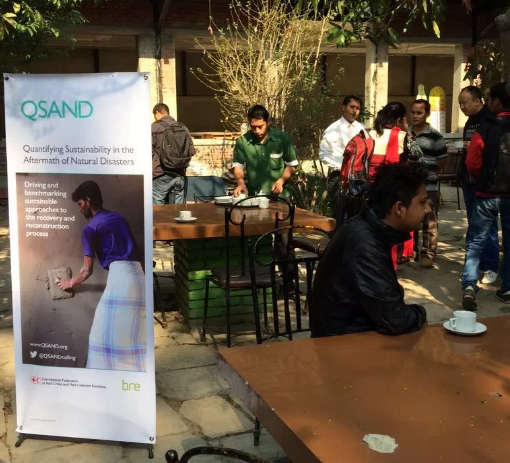QSAND application in Nepal

|
| Disaster response in Gorkha District - Catholic Relief Service's QSAND application in Nepal. |
In April and May 2015, Nepal was struck by a devastating earthquake and series of aftershocks that destroyed or damaged in excess of 800,000 homes and affected over 6 million people (source: Shelter Projects Nepal Earthquake Overview). The severity of the earthquakes, the scale of the damage, and the approaching winter presented serious challenges to relief and recovery efforts.
Immediately following the disaster, a major international response was mobilised. Catholic Relief Services (CRS) were among the organisations to respond, with in-country and international staff involved in recovery efforts in Gorkha District, one of the worst-affected areas.
To aid their response, amongst other tools, CRS used QSAND to measure their performance on issues related to community-sensitive design (including inclusivity and accessibility ), community ownership and sustainable management, material properties and specification, skills and capabilities, and construction approach.
As Minar Thapa Magar, National Coordination Officer for CRS and HRRP-Nepal, explained: “CRS have a strong Monitoring, Evaluation, Accountability, and Learning system in place. QSAND contributed to this by helping to identify indicators to be adopted in the program framework which are periodically evaluated and monitored to improve program quality. The QSAND assessment process gave significant support to our self-reflection of sustainability issues to be addressed in every phase of the project.”

|
| The QSAND Training Course in Kathmandu, March 2016. |
Due to the likely scale of QSAND application in the district and the numbers of stakeholders involved (CRS staff, implementing partners, local and national government representatives, other NGOs etc) a partnership was formed between CRS and BRE to support the project.
Yetunde Abdul, QSAND Programme Manager said; “The CRS Recovery and Resilience Programme in Gorkha has been designed from the beginning with emphasis on environmental and community factors relating to resilience and sustainability. Using QSAND has helped to identify and confirm the good work that has been done so far and has helped improve the planning, design and implementation of the programme.”
The outputs of the QSAND application in the programme have been captured in a case study now available on the QSAND website to view here.
The work that CRS has undertaken in Gorkha has supported local communities to rebuild their lives, and Adeel Javaid, Shelter and Wash Programme Manager at CRS suggests it has shown; “...real potential in supporting and in some cases enhancing the sustainability of our activities and benefits for the affected communities.”
To make an enquiry about QSAND or explore opportunities for its use, please visit the QSAND website or email qsand@bre.co.uk.
This article was originally published on 16 January 2019 on BRE Buzz. It was written by Yetunde Abdul. Ref http://brebuzz.net/2019/01/16/disaster-response-in-gorkha-district-catholic-relief-services-qsand-application-in-nepal/
--BRE Buzz
[edit] Related articles on Designing Buildings Wiki
- BRE Buzz articles on Designing Buildings Wiki.
- BREEAM.
- Building Research Establishment.
- Buildings that help rebuild lives and communities.
- Enhancing community energy resilience, QSAND and Loughborough University Research collaboration.
- Helping achieve the UN's Sustainable Development Goals.
- Helping communities recover from disasters and protecting them before they occur.
- How to rebuild using the debris from disasters.
- Managing and responding to disaster.
- Research and development in disaster response.
- Sustainable Development Goals and civil engineering.
- QSAND.
- QSAND and the Sustainable Development Goals.
- Reconstruction following typhoon Haiyan.
Featured articles and news
RTPI leader to become new CIOB Chief Executive Officer
Dr Victoria Hills MRTPI, FICE to take over after Caroline Gumble’s departure.
Social and affordable housing, a long term plan for delivery
The “Delivering a Decade of Renewal for Social and Affordable Housing” strategy sets out future path.
A change to adoptive architecture
Effects of global weather warming on architectural detailing, material choice and human interaction.
The proposed publicly owned and backed subsidiary of Homes England, to facilitate new homes.
How big is the problem and what can we do to mitigate the effects?
Overheating guidance and tools for building designers
A number of cool guides to help with the heat.
The UK's Modern Industrial Strategy: A 10 year plan
Previous consultation criticism, current key elements and general support with some persisting reservations.
Building Safety Regulator reforms
New roles, new staff and a new fast track service pave the way for a single construction regulator.
Architectural Technologist CPDs and Communications
CIAT CPD… and how you can do it!
Cooling centres and cool spaces
Managing extreme heat in cities by directing the public to places for heat stress relief and water sources.
Winter gardens: A brief history and warm variations
Extending the season with glass in different forms and terms.
Restoring Great Yarmouth's Winter Gardens
Transforming one of the least sustainable constructions imaginable.
Construction Skills Mission Board launch sector drive
Newly formed government and industry collaboration set strategy for recruiting an additional 100,000 construction workers a year.
New Architects Code comes into effect in September 2025
ARB Architects Code of Conduct and Practice available with ongoing consultation regarding guidance.
Welsh Skills Body (Medr) launches ambitious plan
The new skills body brings together funding and regulation of tertiary education and research for the devolved nation.
Paul Gandy FCIOB announced as next CIOB President
Former Tilbury Douglas CEO takes helm.
UK Infrastructure: A 10 Year Strategy. In brief with reactions
With the National Infrastructure and Service Transformation Authority (NISTA).























